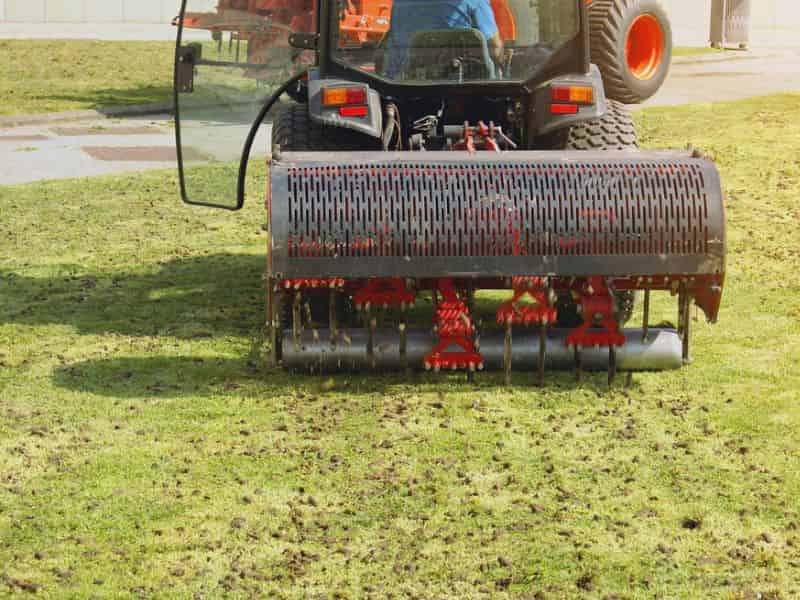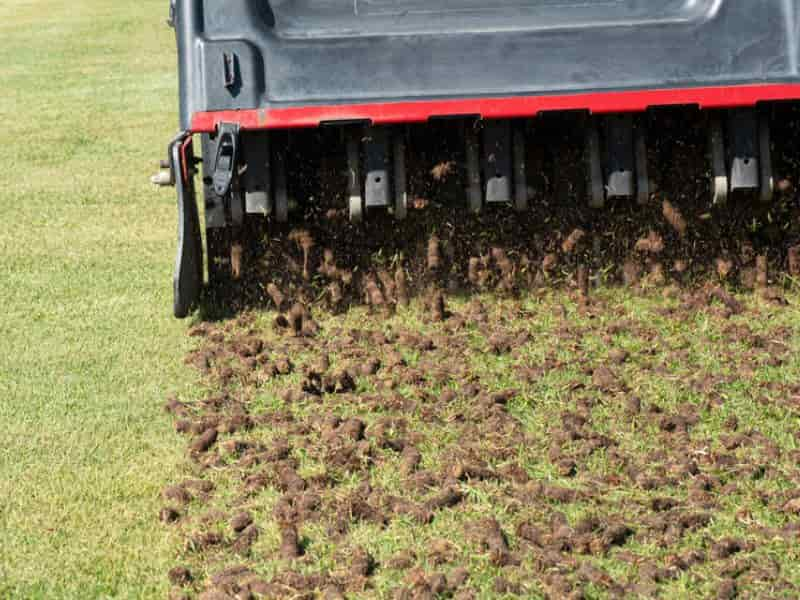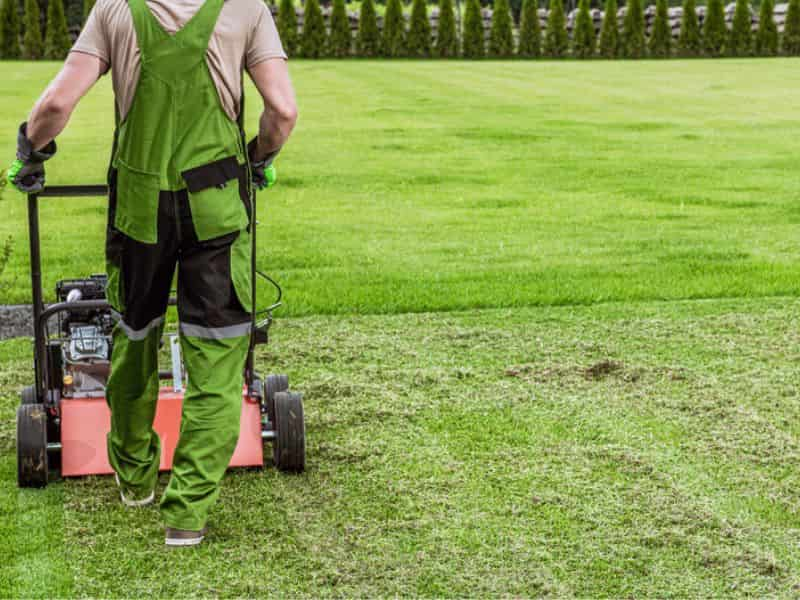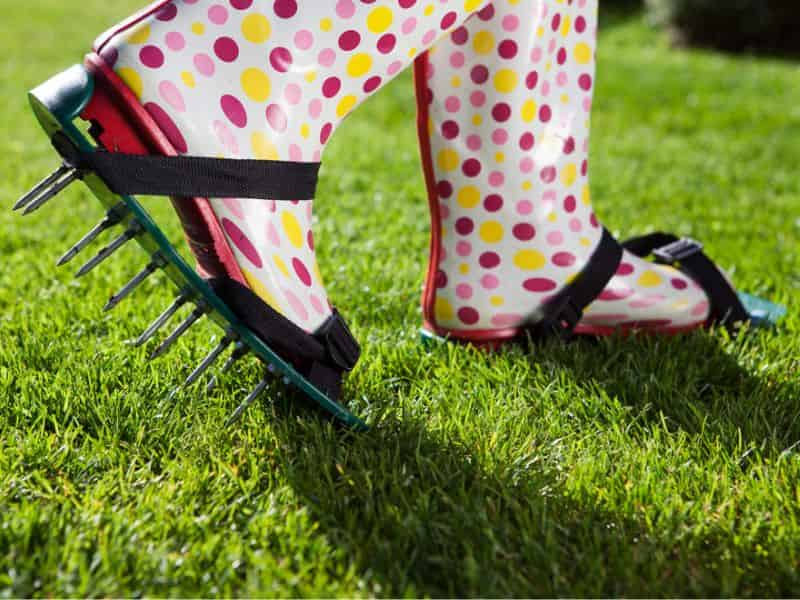How Often Should I Aerate Lawn? (Best Time To Aerate )
The aeration of lawns is a time-consuming lawn maintenance process that involves puncturing small holes in the ground to break up compacted soil and give roots easy access to water, oxygen, and nutrients. It’s one of the important lawn care procedures that lawn owners should carry out or plan for in the grass maintenance routine. But when should you aerate your lawn? How often should you aerate the lawn?
Aerate your lawn once – thrice per annum to reduce soil compaction and increase the flow of air, water, and nutrients to grass roots. Aerate warm-season grass in late spring while cold-season grass onset of spring and fall either with plug or spike methods.
Lets look at how often should a lawn be aerated and what is the best time to aerate depends on what stage of growth your lawn is in details.
Contents
When Should You Aerate Your Lawn?
To benefit from aeration, always carry the procedure during high-growing seasons. Aerating at the start of the peak seasons ensures the holes left behind are filled with grass quickly. Aeration should be done once or twice for plug aeration while twice or thrice yearly for spike -aeration on highly compacted soils with thatch buildups to maintain a healthy lawn, although results are realized 2-3 years.
You should aerate your warm-season grass lawn in late spring or early summer. On the other hand, for cold-season grass, ensure you aerate it at the beginning of spring or early fall.

Compacted soil deprives grass lawns of oxygen, water, and nutrients. In addition, the grass struggles more in stressful conditions like low rainfall and heat and tends to lose its healthy, rich color. Ensure you check the weather conditions to reduce these constraints. Successful aeration should open up a way for grassroots to get these essential elements. The plugs of soil left on top of the soils will break down with time. To achieve the best results of beautiful lawn, couple aeration with basic lawn care practices such as properly mowing, fertilizing and adequate watering.
Depending on the lawn size, you can aerate by hand or machine. But how should you aerate?
Aerate Your Lawn (Step by Step Procedure)

- If it has not rained for some time, water the lawn (irrigate about 1 inch) to soften the ground.
- To avoid accidental run over, map/mark the septic line, water, sprinkler system, power, or any other utility you may have on your lawn.
- Get your aerator and go through the lawn in one direction. Go through the whole ground, but if it’s the first time to aerate, you can go through the second time perpendicular to the first time.
- Aeration removes small plugs, and let them break down to add nutrients to the lawn.
- Water the lawn well once finished aerating. You can now reseed the bare spots with desired grass seeds. Water generously for the next couple of weeks for every 2-4 days. Consider fertilizing and other simple lawn repair procedures.
Note: Combining these practices helps put the lawn on fast track with quick seed establishment for a thick-lusher lawn.
When To Aerate the Lawn?
The best time to aerate and dethatch your lawn is when the grass is actively growing just before the peak period. Aeration is an essential care and maintenance procedure beneficial to grow grass thicker and greener. Proper and accurate timing for aeration is key to a healthy-lush lawn. You should never aerate dormant grass; it can stress the grass.

But how do you determine if you should be aerating your lawn? Here are a few signs to look for:
- When your lawn is not growing as it should, it may result from thatch buildup or compacted soil, even when feed and weeds controls are done. You can test your soil with a screwdriver; if you cant easily insert a screwdriver into the soil, consider aerating.
- If your lawn feels spongy after watering and difficult to stick your finger through to the soil, you are a candidate for dethatching or aerating the lawn.
- If you have pets, kids, or people playing on the lawn or maybe a car or small equipment passing through the lawn, you may have compacted soil even if it doesn’t look so.
- If the rains puddle or make the lawn soggy where it used to get through the soil, or it feels hard to touch with stress-looking grass, your lawn may be compacted.
- If you live in a region with clay soil, you must aerate yearly to keep a thick green strong, healthy lawn. Aeration improves clay soil for your lawn.
Note: Your soil is well aerated if you have sandy or loam soil. Thus, you should aerate once in 2-3 years.
- Did you establish lawn through sods? If so, you need to aerate the lawn to remove the soil layering that may affect water drainage from the finer textures of the soil. Such layering hinders root development; thus, aerating help breaks this layer and allows water and nutrients to flow through the soil easily to the grassroots.
See Also: Spike Vs. Plug Aerator; Which is Better?
How Often Should I Aerate My Lawn?
The general rule is to aerate your lawn once or twice yearly for plug aeration while twice or thrice yearly for spike aeration. It will take approximately three years to realize the full effect of either method.
Aerate your lawn during or before your grass reaches its peak growth. Warm-season grasses like Centipede grass and Bermuda grass should be aerated in the late spring or early summer (April to July) when they are actively growing. Cool-season grasses like fescue and ryegrass should be aerated in early fall or early spring.

However, this may be the exception, depending on the condition of your lawn.
Note: Aerate your lawn more frequently if it meets the following conditions:
- When the soil is compact, it does not drains water properly after rain or irrigation. Perform a screwdriver test on your lawn to confirm if it’s compacted. Stick a screwdriver in your lawn. If it resists and does not move easily, the soil is compacted, and you should aerate it.
- If there has been construction in the area.
- If it’s an area with heavy traffic from children, pets, and vehicles.
- When the grass becomes dry, thin, discolored, and diseased.
- If the grass is spongy, indicating dense thatch build-up.
- If there’s been a recent sod installation and there is soil layering.
The soil type will also determine the frequency of aeration. Sandy soils can go for several years without aeration, while clay soil will require more frequent aeration. If you are doing spike aeration, aerate up to thrice a year.
Read More: How to Overseed a Lawn Without Aerating
What Is lawn Aeration?
Lawn aeration is basically making holes using hollow tines on grass lawn to allow air, water and nutrients penetrate and reach the grass roots. It can be done through use of spike aerators, core aerators, liquid aerator, and slice aerator to encourage root growth improving its torrerance to drought, pest problems and other issues that may affect grass. Making the hole or removing soil plugs allow enhance drainage and reduces chance of runoff leaving the lawn soggy.
Why do lawns need Aeration?
Lawn aeration solves soil compaction problems that makes the soil impenetratable, inhibiting roots access to air, water and nutrients that end up affecting the grass ability to thrive. A well aerated soil supports deeper grass roots penetration, supports root system and enhance decomposition of organic matter which leads to new shoots, and strong grass stems especially for heavy clay soils.
Factors That Determine How Often To Aerate Your Lawn?
The no of times to aerated depends on how compacted the soil is, the traffic on your lawn and the number of times you have aerated before. Aeration can help repair the damage and strengthen the grass. Here are few consideration when aerating lawn:
- Soil type and composition: The soil type and its composition play an important role in determining how compact it gets and thus influence the number of time it needs to aerate.
- Foot traffic and type of lawn usage – if your lawn experience heavy foot traffic, such as those with kids and pets playing on them, it’s more likely most compact, and might require more frequent aeration than those will little foot traffic.
- Environmental condition – the climatic and seasonal changes experienced by your region or area may play an important role in determining how many times to aerate, especially with the soil type.
- Grass Type and its health – the grass in your lawn also determines the number of times it needs to be aerated. This care and maintenance create some disturbance in the growth of the grass lawn; thus, its health with influence the practice.
- The number of times it has been aerated – Previous aeration confirms previous attempts to increase the availability of essential resources to the grass root. This may reduce the number of times you can aerate compared to the first time you carry out this procedure.
- Method of aeration – Different methods of aeration have different degrees of efficiency in different grass types and soil compositions depending on how compact the soil is; target to use a method that efficiently increases access to water, air, and nutrients for your grass lawn.
Final Thought
You should aerate your lawn in early spring or fall for cool-season grass type, and late spring to early summer for warm-season grass types. Its best to consider the grass type, its health, climatic condition, season, foot traffic, soil type and composition, and whether previously aerated or not. You should target aerating your lawn on yearly basis at least once per year.
Ensure you remove thatch layers that may may hinder or be a barrier to grass roots thriving and prevent access to water or rainfall. Add compost or organic debris after earation to encourage grass growth and maintain water after irragation.
Reference
Virginia Cooperative Extension: Aerating Your Lawn.


